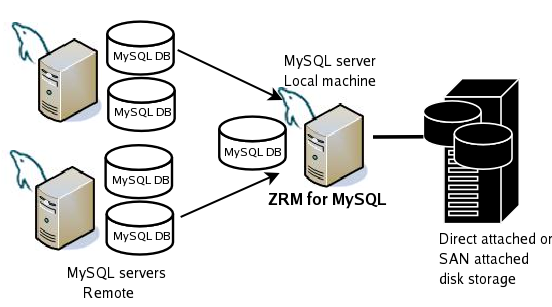Zmanda Recovery Manager for MySQL: Difference between revisions
No edit summary |
|||
| (8 intermediate revisions by the same user not shown) | |||
| Line 1: | Line 1: | ||
'''Please see [[Zmanda Recovery Manager for MySQL Users Manual]] for release 1.1.3 and later releases | |||
''' | |||
Zmanda Recovery Manager for MySQL (MySQL ZRM) is a flexible and robust backup and recovery solution for MySQL server. It also provides users the capability to schedule and get | Zmanda Recovery Manager for MySQL (MySQL ZRM) is a flexible and robust backup and recovery solution for MySQL server. It also provides users the capability to schedule and get reports on the backup of MySQL Databases. MySQL ZRM has plugin interfaces that allow ZRM to be customized to the IT environment. | ||
MySQL ZRM supports backups of MySQL databases residing on the local server as well as remote servers. It does backup to direct attach or SAN attached disk storage or NAS/SAN storage appliances. Following diagram shows a server running MySQL ZRM backing up 2 MySQL servers with multiple MySQL databases and the local MySQL server. | |||
[[Image:MySQL_ZRM.png|center]] | |||
This manual discusses installation, configuration, backup, recovery and reporting features of MySQL ZRM. This document was prepared for ZRM for MySQL release 1.1.3 | |||
# [[What does MySQL ZRM run on?]] | |||
# [[I have questions/suggestions/bug fixes. How do I contact other users/developers? ]] | |||
# [[What can MySQL ZRM do?]] | |||
# [[What will be implemented in future releases?]] | |||
# [[How do you install MySQL ZRM?]] | |||
# [[Quick start example]] | |||
# [[Do I need to make changes to MySQL database configuration?]] | |||
# [[How do I configure MySQL ZRM?]] | |||
# [[Finally, Can I do MySQL backups?]] | |||
# [[Backups failed. What do I do?]] | |||
# [[Backup compression and encryption]] | |||
# [[What information can be obtained from a backup report?]] | |||
# [[How do I recover data when there is a failure or data loss?]] | |||
# [[How did the MySQL ZRM do the job?]] | |||
# [[How to create custom plugins for MySQL ZRM?]] | |||
# [[How do I tune MySQL backup performance?]] | |||
Latest revision as of 22:33, 30 January 2007
Please see Zmanda Recovery Manager for MySQL Users Manual for release 1.1.3 and later releases
Zmanda Recovery Manager for MySQL (MySQL ZRM) is a flexible and robust backup and recovery solution for MySQL server. It also provides users the capability to schedule and get reports on the backup of MySQL Databases. MySQL ZRM has plugin interfaces that allow ZRM to be customized to the IT environment.
MySQL ZRM supports backups of MySQL databases residing on the local server as well as remote servers. It does backup to direct attach or SAN attached disk storage or NAS/SAN storage appliances. Following diagram shows a server running MySQL ZRM backing up 2 MySQL servers with multiple MySQL databases and the local MySQL server.

This manual discusses installation, configuration, backup, recovery and reporting features of MySQL ZRM. This document was prepared for ZRM for MySQL release 1.1.3
- What does MySQL ZRM run on?
- I have questions/suggestions/bug fixes. How do I contact other users/developers?
- What can MySQL ZRM do?
- What will be implemented in future releases?
- How do you install MySQL ZRM?
- Quick start example
- Do I need to make changes to MySQL database configuration?
- How do I configure MySQL ZRM?
- Finally, Can I do MySQL backups?
- Backups failed. What do I do?
- Backup compression and encryption
- What information can be obtained from a backup report?
- How do I recover data when there is a failure or data loss?
- How did the MySQL ZRM do the job?
- How to create custom plugins for MySQL ZRM?
- How do I tune MySQL backup performance?